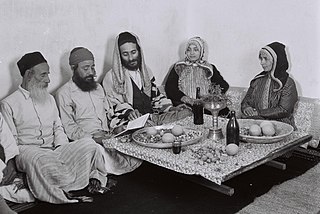
Yemenite Jews, also known as Yemeni Jews or Teimanim, are Jews who live, or once lived, in Yemen, and their descendants maintaining their customs. Between June 1949 and September 1950, the overwhelming majority of the country's Jewish population immigrated to Israel in Operation Magic Carpet. After several waves of persecution, the vast majority of Yemenite Jews now live in Israel, while smaller communities live in the United States and elsewhere. As of 2022, Levi Marhabi is the last Jew in Yemen.

Yemen, officially the Republic of Yemen, is a sovereign state in West Asia. Located in the southern Arabian Peninsula, it borders Saudi Arabia to the north, Oman to the northeast, and the Indian Ocean to the south, sharing maritime borders with Eritrea, Djibouti and Somalia across the Horn of Africa. Covering roughly 528,000 square kilometres, with a coastline of approximately 2,000 kilometres, Yemen is the second largest country on the Arabian Peninsula. Sanaa is its constitutional capital and largest city. Yemen's estimated population is 34.7 million, mostly Arab Muslims. It is a member of the Arab League, the United Nations, the Non-Aligned Movement and the Organisation of Islamic Cooperation.
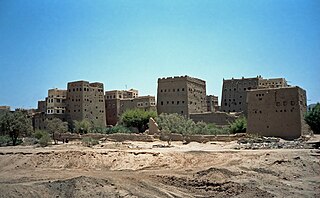
Saada or Sa'dah is one of the governorates of Yemen. The governorate's seat and the largest city is Saada. It is the epicentre of Zaydism and where the Houthi group originates from.
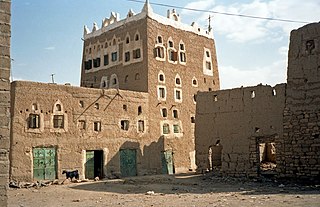
Saada, a city and ancient capital in the northwest of Yemen, is the capital and largest city of the governorate of the same name, and the seat of the eponymous district. The city is located in the mountains of Serat (Sarawat) at an altitude of about 1,800 meters. In 2004, it was the tenth-largest city in Yemen and had an estimated population of 51,870.

The Houthi insurgency, also known as the Houthi rebellion, the Sa'dah War, or the Sa'dah conflict, was a military rebellion pitting Zaidi Shia Houthis against the Yemeni military that began in Northern Yemen and has since escalated into a full-scale civil war. The conflict was sparked in 2004 by the government's attempt to arrest Hussein Badreddin al-Houthi, a Zaidi religious leader of the Houthis and a former parliamentarian on whose head the government had placed a $55,000 bounty.

Adeni Jews, or Adenite Jews are the historical Jewish community which resided in the port city of Aden. Adenite culture became distinct from other Yemenite Jewish culture due to British control of the city and Indian-Iraqi influence as well as recent arrivals from Persia and Egypt. Although they were separated, Adeni Jews depended on the greater Yemenite community for spiritual guidance, receiving their authorizations from Yemeni rabbis. Virtually the entire population emigrated from Aden between June 1947 and September 1967. As of 2004, there were 6,000 Adenites in Israel, and 1,500 in London.
The history of the Jews in the United Arab Emirates describes the historical and modern presence of Jews over the millennia in the Middle East and the recorded meetings with Jewish communities in areas that are today in the geographic territories of the United Arab Emirates.

The history of the Jews in the Arabian Peninsula dates back to Biblical times. The Arabian Peninsula is defined as including the present-day countries of Bahrain, Kuwait, Oman, Qatar, Saudi Arabia, United Arab Emirates and Yemen politically and parts of Iraq and Jordan geographically.
The Constitution of Yemen provides for freedom of religion, and the Government generally respected this right in practice; however, there were some restrictions. The Constitution declares that Islam is the state religion, and that Shari'a is the source of all legislation. Government policy continued to contribute to the generally free practice of religion; however, there were some restrictions. Muslims and followers of religious groups other than Islam are free to worship according to their beliefs, but the Government prohibits conversion from Islam and the proselytization of Muslims. Although relations among religious groups continued to contribute to religious freedom, there were some reports of societal abuses and discrimination based on religious belief or practice. There were isolated attacks on Jews and some prominent Zaydi Muslims felt targeted by government entities for their religious affiliation. Government military reengagement in the Saada governorate caused political, tribal, and religious tensions to reemerge in January 2007, following the third military clash with rebels associated with the al-Houthi family, who adhere to the Zaydi school of Shi'a Islam.
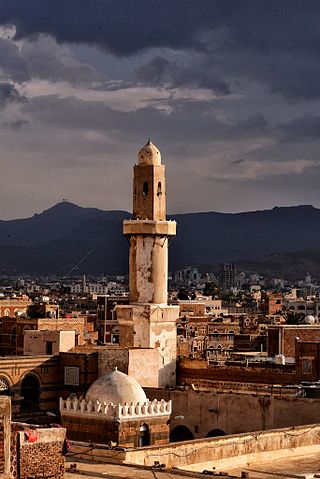
Yemen is an Islamic country. Nearly all Yemenis are Muslims, The U.S. government estimates that more than 99 percent of the population is Muslim. with approximately 60% belonging to Sunni Islam and 40% belonging to Shia Islam (Zaidi). Amongst the native population, there were approximately 1,000 Christians, and 6 remaining Jews in 2016. However, Pew-Templeton estimates the number of Christians to be as high as 40,000, though most do not publicly identify as such, due to fears of religious persecution. According to WIN/Gallup International polls, Yemen has the most religious population among Arab countries and it is one of the most religious populations world-wide.

The Houthi movement, officially known as Ansar Allah, is a Shia Islamist political and military organization that emerged from Yemen in the 1990s. It is predominantly made up of Zaidi Shias, with their namesake leadership being drawn largely from the Houthi tribe.
Moshe Ya'ish al-Nahari was a Yemeni Jewish Hebrew teacher and kosher butcher in Raydah, Yemen, who was murdered by a Yemeni Muslim who accosted him near his home demanding that he convert to Islam. Al-Nahari's attacker subsequently boasted of the killing and the prosecution demanded the death penalty. The court ruled that the attacker was mentally unstable and ordered him to pay damages. In the subsequent appeals case, however, al-Abdi was sentenced to death. The murder of al-Nahari was the first of its kind in at least fifteen years.
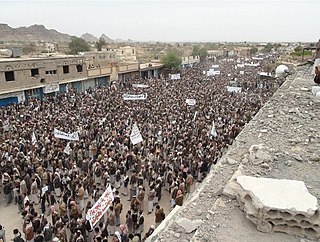
The Battle of Saada was a military confrontation that erupted in March 2011 between Houthi rebels and tribal forces loyal to Yemeni President Ali Abdullah Saleh in the northern city of Saada. Following days of heavy clashes, the Houthis managed to capture the entire Saada Governorate including its provincial capital and established an independent administration, thereby marking the first such Yemeni governorate to fall out of central government control since the nationwide uprising began in 2011. Saada later becomes known as the Houthi stronghold since its takeover.

The siege of Dammaj began in October 2011 when the Houthis, a Zaydi-led rebel group which controls the Sa'dah Governorate, accused Salafis loyal to the Yemeni government of smuggling weapons into their religious center in the town of Dammaj and demanded they hand over their weapons and military posts in the town. As the Salafis refused, Houthi rebels responded by imposing a siege on Dammaj, closing the main entrances leading to the town. The town was controlled by the Houthis and the fighting was mainly centered at Dar al-Hadith religious school, which was operated by Salafis.
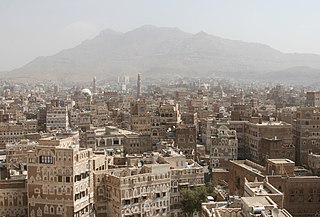
The Battle of Sanaa in 2014 marked the advance of the Houthis into Sanaa, the capital of Yemen, and heralded the beginning of the armed takeover of the government that unfolded over the following months. Fighting began on 9 September 2014, when pro-Houthi protesters under the command of Abdul-Malik al-Houthi marched on the cabinet office and were fired upon by security forces, leaving seven dead. The clashes escalated on 18 September, when 40 were killed in an armed confrontation between the Houthis led by military commander Mohammed Ali al-Houthi and supporters of the Sunni hardliner Islah Party when the Houthis tried to seize Yemen TV, and 19 September, with more than 60 killed in clashes between Houthi fighters and the military and police in northern Sanaa. By 21 September, the Houthis captured the government headquarters, marking the fall of Sanaa.

Yemenite Jews in Israel are immigrants and descendants of the immigrants of the Yemenite Jewish communities, who now reside within the state of Israel. They number around 400,000 in the wider definition. Between June 1949 and September 1950, the overwhelming majority of Yemen and Aden's Jewish population was transported to Israel in Operation Magic Carpet.
The battle of 'Amran, refers to a battle that took place in the summer of 2014, between the Houthi Zaydi movement, and the Yemeni government of President Abdrabbuh Mansur Hadi. The Houthis eventually won the battle, leading them to the capture of Sanaa.

Mohamed al-Atifi is the Defence Minister of the Houthi government since 28 November 2016.

Shia Islam in Yemen is practiced by a substantial minority of the population, with the vast majority of Shia Muslims in Yemen being Zaydi, while a minority are Twelver and Isma'ili. Sunni Muslims make up 65% percent of Yemen, while 35% of the country are Shia Muslims. These Shia Muslims are predominantly concentrated in the northwestern regions of the country, including the capital and major cities that are some of the most densely populated areas of Yemen.
The following is a timeline of the Yemeni humanitarian crisis, ongoing since the mid-2010s.
















